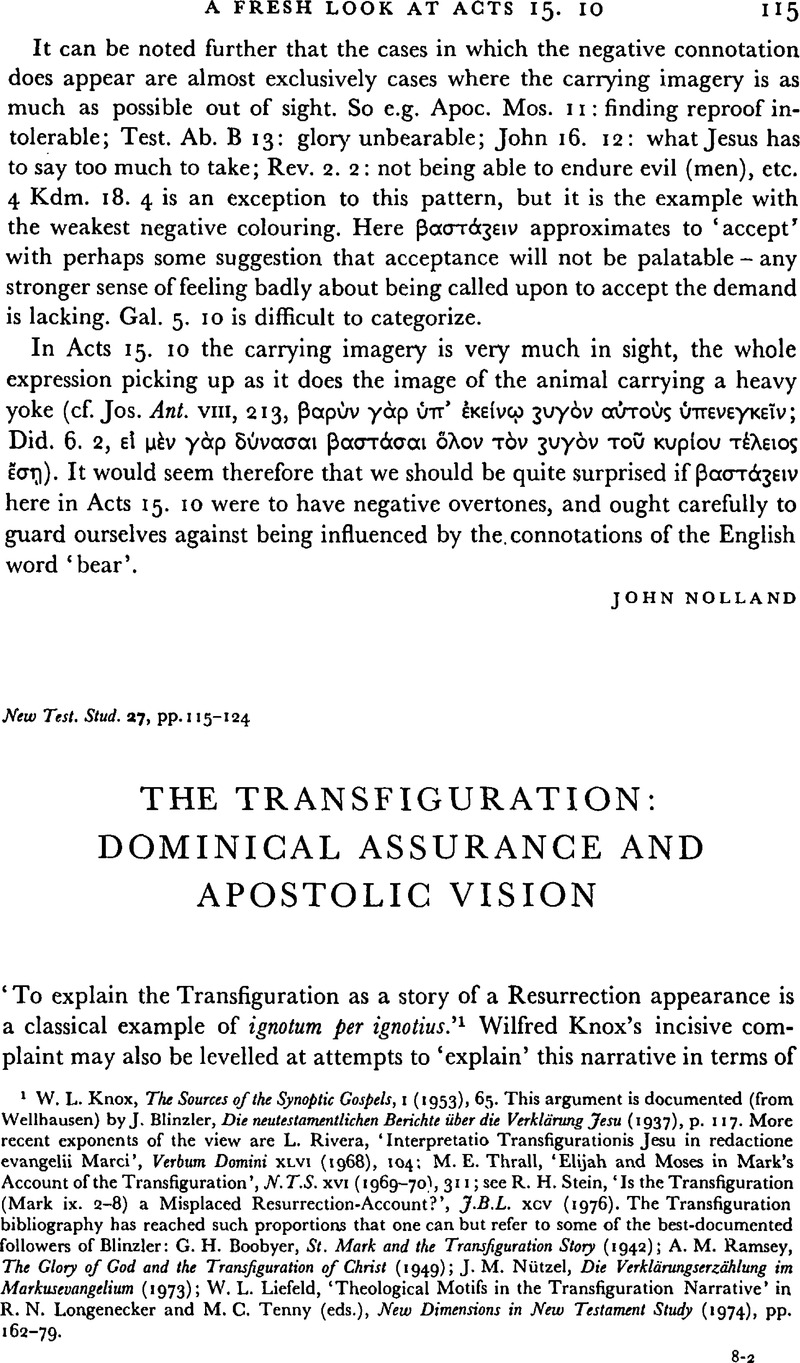Published online by Cambridge University Press: 05 February 2009

1 Knox, W. L., The Sources of the Synoptic Gospels, 1 (1953), 65Google Scholar. This argument is documented (from Wellhausen) by Blinzler, J., Die neutestamentlichen Berichte über die Verklärung Jesu (1937), p. 117Google Scholar. More recent exponents of the view are Rivera, L., ‘Interpretatio Transfigurationis Jesu in redactione evangelii Marci,’ Verbum Domini 46 (1968), 104Google Scholar; Thrall, M. E., ‘Elijah and Moses in Mark's Account of the Transfiguration,’ N.T.S. 16 (1969–1970), 311Google Scholar; see Stein, R. H., ‘Is the Transfiguration (Mark ix. 2–8) a Misplaced Resurrection-Account?,’ J.B.L. 95 (1976)Google Scholar. The Transfiguration bibliography has reached such proportions that one can but refer to some of the best-documented followers of Blinzler: Boobyer, G. H., St. Mark and the Transfiguration Story (1942)Google Scholar; Ramsey, A. M., The Glory of God and the Transfiguration of Christ (1949)Google Scholar; Nützel, J. M., Die Verklärungserzählung im Markusevangelium (1973)Google Scholar; Liefeld, W. L., ‘Theological Motifs in the Transfiguration Narrative’ in R. N. Longenecker and M. C. Tenny (eds.), New Dimensions in New Testament Study (1974), pp. 162–79.Google Scholar
2 Boobyer.
3 Riesenfeld, H., Jésus Transfiguré (1947).Google Scholar
4 McCurley, F. R., ‘“And after six days” (Mark ix. 2), a Semitic literary device,’ J.B.L. 93 (1974), 79.Google Scholar
5 Carlston, C. E., ‘Transfiguration and Resurrection,’ J.B.L. 80 (1961), 234.Google Scholar
6 Burkill, T. A., Mysterious Revelation (1963), p. 241.Google Scholar
7 Müller, U. B., ‘Die christologische Absicht des Markusevangeliums und die Verklärungsgeschichte,’ Z.N.W. 64 (1973), 176.Google Scholar
8 Ibdid.
9 Knox, p. 64; Burkill, p. 180; Müller, p. 176.
10 The Gospel According to St. Mark (1908), p. xlvii.
11 Müller, p. 179.
12 Rivera, p. 101.
13 Rivera, p. 102.
14 Bowman, J. W., The Gospel of Mark (1965), p. 193Google Scholar; Müller, p. 181; Räisänen, H., Das ‘Messiasgeheimnis’ im Markusevangelium (1976), p. 113Google Scholar remarks on the emphasis on what is seen in v. 9.
15 Braithwaite, W. C., ‘The Teaching of the Transfiguration,’ Exp. T. 17 (1905–1906), 372Google Scholar. The use by Matthew and Luke of elements in the narrative which analysis has shown to be Markan redactional establishes the Markan priority hypothesis in this instance. It is also to be seen as prior to the notices in II Peter and the Apocalypse of Peter.
16 Rescarch in this area has been particularly vigorous; see, e.g., Teeple, H. M., The Mosaic Eschatological Prophet (1957), p. 116Google Scholar: Mauser, U., Christ in the Wilderness (1963), pp. 111 f.Google Scholar; McCurley, pp. 75 f.; Rivera, p. 102; Kee, H. C., Community of the New Age (1977), pp. 44 f.Google Scholar
17 Cf. 4 QEn edited by Milik, J. T., The Books of Enoch (1976), p. 205Google Scholar; Rivera, p. 103; McCurley, p. 79. The Jerusalem Targum to Exod. 33. 23 has already been noted, and there are similar analogies in the Transfiguration to other Jewish Moses traditions. According to Philo (‘Questions and Answers on Exodus’, II. 29, quoting from the Marcus translation in the Loeb Library), Moses was ‘changed into the divine’ on Sinai. Josephus (Antiquities IV. 326 from the Thackeray edition in the same series) has Moses disappear (άφανίзεται) while speaking with Eleazar and Joshua ('ίησο腡ς). That Josephus has a translation in mind is evident from the fact that he uses the noun άφανεīς to describe Elijah and Enoch (IX. 28b). The three figures in Josephus (Moses, Eleazar, Jesus) may themselves be related to the three in Mark's tradition (Jesus, Moses, Elijah). In Jewish tradition, according to Origen, Φινεές το腦'Ελεαзάρου υίόν … αύτόν είναι '$$$λίαν (quoted by Hengel, M., Die Zeloten (1961), p. 168Google Scholar note 3). Hengel (pp. 167 f.) presents further evidence for the identification of Elijah with Phineas. If this identification also extended to Eleazar, then Josephus' figures would be directly related to Mark's, and it is notable that the Samaritan version actually reads ‘Eleazar’ at Exod. 24. 1. There is no immediate evidence that Mark's narrative is patterned on one similar to that of Josephus in this regard, but we must at least conclude that the naming of Moses' companions at crucial moments in his dealings with God was a significant part of Jewish speculation and that it reveals another aspect of the relationship between Exod. 24 and Mark 9.
18 Müller, H.-P., ‘Die Verklärung Jesu. Eine motivgeschichtliche Studie,’ Z.N.W. 51 (1960), 58.Google Scholar
19 A full treatment of this saying and its parallels will be found in my thesis, God in Strength (Cambridge, 1976), pp. 167–83.Google Scholar
20 For the rabbinic and pseudepigraphal use of this phrase, see op. cit. pp. 179 ff.
21 See Schulz, S., ‘Die Decke des Moses. Untersuchungen zu einer vorpaulinischen Überlieferung in II Cor. iii. 7–18,’ Z.N.W. 49 (1958), 28 f.Google Scholar
22 For an extended treatment of this see Kenny, A., ‘The Transfiguration and the Agony in the Garden,’ C.B.Q. 19 (1957).Google Scholar